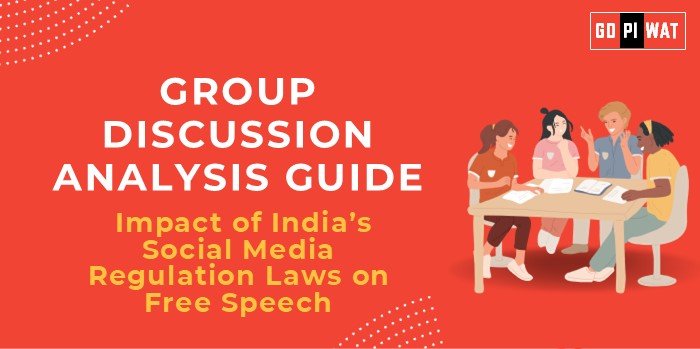📋 Group Discussion (GD) Analysis Guide: Impact of India’s Social Media Regulation Laws on Free Speech
🌐 Introduction to the Topic
Opening Context: In the world’s largest democracy, social media serves as a vital platform for expression. However, recent regulatory measures have sparked debates about their implications for free speech.
Background: India’s Information Technology (Intermediary Guidelines and Digital Media Ethics Code) Rules, 2021, aim to address issues like misinformation and hate speech. Critics, however, argue that these regulations may suppress legitimate expression.
📊 Quick Facts and Key Statistics
- Active Social Media Users in India: Approximately 467 million as of January 2023, highlighting the platform’s extensive reach.
- Compliance with IT Rules 2021: Major platforms like Facebook and Twitter have appointed grievance officers in India, indicating adherence to new regulations.
- Content Takedown Requests: Between January and June 2022, India made 24,350 content removal requests to Twitter, the highest globally.
- Freedom on the Net 2022 Report: India scored 51 out of 100, categorized as “Partly Free,” reflecting concerns over internet freedom.
🔍 Stakeholders and Their Roles
- Government: Implements regulations to curb online threats and maintain national security.
- Social Media Platforms: Act as intermediaries balancing user expression with legal compliance.
- Civil Society and Activists: Advocate for the protection of free speech and demand transparency in regulatory practices.
- Citizens: Utilize platforms for expression, often navigating the complexities of censorship and regulation.
🏆 Achievements and Challenges
✨ Achievements
- Reduction in Misinformation: Initiatives have led to a decrease in the spread of fake news, enhancing information reliability.
- Enhanced Accountability: Platforms are now more responsive to grievances due to mandated compliance structures.
- National Security: Stricter regulations have curtailed the dissemination of harmful content, promoting societal safety.
⚠️ Challenges
- Chilling Effect: The fear of punitive action may lead to self-censorship among users.
- Lack of Transparency: Ambiguities in content removal processes can erode public trust.
- Comparative Disadvantage: Countries like the U.S. offer broader free speech protections, highlighting potential overreach in India’s regulations.
🌍 Global Comparisons
- Germany’s NetzDG Law: Balances regulation and free speech with clear accountability measures.
- China’s Model: Highly restrictive, illustrating the potential pitfalls of excessive control.
📜 Case Studies
- India: The Supreme Court’s 2015 judgment in Shreya Singhal v. Union of India struck down Section 66A of the IT Act, emphasizing the importance of free speech.
- Regional Example: The Delhi High Court’s 2021 ruling on arbitrary content takedown highlighted the need for judicial oversight in content regulation.
📚 Structured Arguments for Discussion
- Supporting Stance: “Social media regulations are essential for maintaining societal harmony and curbing online abuse.”
- Opposing Stance: “Overregulation risks stifling legitimate dissent and creativity in a democratic society.”
- Balanced Perspective: “While regulation is necessary, transparency and clear redress mechanisms are vital to safeguard free speech.”
✅ Effective Discussion Approaches
- Opening Approaches:
- Utilize statistics to highlight the scale of India’s social media usage.
- Introduce international examples for contrast.
- Share recent cases to illustrate the topic’s real-world relevance.
- Counter-Argument Handling:
- “While safety is essential, are there safeguards against the misuse of these laws?”
- “If platforms operate transparently, how can censorship concerns be addressed?”
📊 Strategic Analysis of Strengths and Weaknesses
- Strengths: Protection against fake news, established grievance redressal systems.
- Weaknesses: Risk of arbitrary enforcement, potential to stifle dissent.
- Opportunities: Leveraging AI for transparent moderation, positioning as a global leader in balanced regulation.
- Threats: Reputational harm due to international criticism, erosion of public trust.
📈 Connecting with B-School Applications
- Real-World Applications:
- Explore governance frameworks in public policy courses.
- Research ethical considerations in technology management.
- Sample Interview Questions:
- “What’s your opinion on balancing free speech and regulation?”
- “How can India’s regulations inspire global digital policies?”
- Insights for B-School Students:
- Study how businesses adapt to evolving regulations.
- Analyze the role of digital ethics in decision-making.


